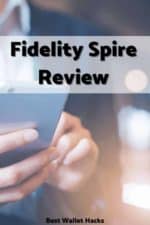Free financial apps make it easy to invest, most lack extensive financial planning tools. A lack of in-depth features makes it challenging to craft practical money goals. The status quo is changing with Fidelity Spire – a free app for financial planning and investing.
This Fidelity Spire review shows how this new app can help plan your financial future. It works best when linked to your Fidelity accounts and allows you to create and track short and long-term goals. You’ll always know if you are on track, or how a new goal will affect your other timelines. It also provides financial education that matches where you are.
For example, f you are building your emergency fund you’ll get articles about the importance of saving. However, if you are investing, you’ll receive investment advice.
Table of Contents
What is Fidelity Spire?
As its name implies, the legendary Fidelity Investments powers Spire that is also Fidelity’s first new mobile app in ten years. You can expect access to Fidelity’s many banking and investing resources in addition to the financial planning tools.
This app is free and works on most Android and iOS devices. You must be at least 18 years old and live in the United States to use Fidelity Spire.
Fidelity Spire is an app built primarily for young adults who have little experience managing money. Any person at least 18 years old can use Spire to plan and track short-term and long-term goals.
Some of the Spire app’s main features include:
- Short-term goals planning
- Long-term goals planning
- Financial decisions tool
- Learning library
- In-app investing, including fractional shares
Many young adults know the importance of investing and managing money well. However, planning and tracking money goals is difficult if you have never done it.
While there are a plethora of money apps already, having an app with the Fidelity name on it can add an extra layer of credibility.
Do You Need a Fidelity Account to use Fidelity Spire?
You can use Spire with no obligation to join Fidelity. It’s possible to link your external accounts and track your goals but the app is intended to use with your Fidelity accounts and that is how it works best.
For example, you may open a Fidelity Cash Management Account to track your short-term goals and a Fidelity Go robo-advisor account to track long-term goals.
Using Fidelity Spire
You will need to download Fidelity Spire to your iOS or Android device. After joining, Spire can help personalize your short-term and long-term goals.
It does yet use their Fidelity Goal Booster technology. If you saved a goal in Goal Booster, it doesn’t show up in Spire yet.
The app also asks if you want to join Fidelity, but you can complete the enrollment process later. Linking your Fidelity accounts or opening a new account lets you enjoy full access to Spire.
If you open a Fidelity Cash Management or Fidelity Go account, you can schedule transfers from your current bank accounts. Each transfer updates your goal progress.
You can continue using Fidelity Spire to track your current goals or make new ones. There is also a decision tool to help you decide how quickly you can reach a goal if you boost your monthly savings rate.
You may notice that Spire compiles many existing Fidelity products and packages them into an app-friendly manner for Fidelity Spire. Each Fidelity product is good but it can be easier to find them in the Spire app than on the Fidelity website.
Financial Planning Tools
The primary reason to use Fidelity Spire is for its financial planning tools. These features help make this Spire different than most budgeting apps and investing apps that focus on one topic.
Here’s an in-depth look at the various planning tools.
Track
Spire describes itself as a “goals-based app.” Setting money goals and tracking your progress is a Fidelity Spire cornerstone, as you might expect.
The Track tool is your hub for making short-term and long-term goals and following through. You can create multiple goals and prioritize your most important ones. Linking your financial accounts is optional but lets you track your goals.
This tool provides a basic overview of your financial progress, similar to Personal Capital. You can categorize transactions but won’t build an in-depth monthly budget like Mint or EveryDollar. Instead, you will need to decide where to reduce spending if you’re not saving enough for your goals.
Here’s our full review of Personal Capital.
Decision
There is an opportunity cost to most big money decisions – and any life decision. The Decision feature compares which tradeoffs you make for two goals that you choose.
Decision asks how much spare cash you want to dedicate to a goal. The tool lets you adjust your monthly commitment to both goals.
You can see how pursuing one goal first impacts the timeline of achieving your other goals.
Instead of making a decision by yourself or asking, “What if?” after it’s too late, you can make an informed decision.
Full View
Fidelity Full View lets you link your Fidelity and non-Fidelity accounts to Spire. Other Fidelity services use Full View as well. This tool makes it easy to track your goals in Spire and also calculate your net worth.
If Fidelity can’t sync an external account, you can add it manually. You will also have to update it manually when you want to see your Full View.
Learn
In addition to making goals and tracking your progress, you can boost your money knowledge. You will find articles on a variety of topics including:
- Budgeting
- Career
- Health
- Investing
It’s possible to browse articles by money goal type as well. For instance, you may want to read articles about becoming debt-free, maximizing your money, and starting a family.
Fidelity sources these quick-read articles from leading financial outlets. A few other money apps offer similar content and can introduce you to topics you don’t think about regularly.
Virtual Assistant
We’re seeing more apps use interactive chatbots to help answer questions you have about using their service. Fidelity Spire has an artificial intelligence – Virtual Assistant – you can ask various money and app navigation questions.
For the most part, Virtual Assistant helps you navigate the Fidelity platform. You may also be able to find answers for basic investing questions like stock price quotes or “What’s an expense ratio?”
This tool is helpful yet the Track, Decision and Learn tools continue to be the real reasons to use Spire. Like any customer support tool, you won’t get personal financial advice.
In-App Trading
In March 2021, Fidelity Spire introduced in-app trading – whereas before the trading was done through your Fidelity account, you will now be able to trade stocks, including fractional shares, within the app itself.
With the launch of in-app trading, they also have expanded their educational resources to help folks better understand how it all works.
How Fidelity Spire Helps with Short-Term Goals
Fidelity Spire can help you plan for short-term goals like saving for an emergency fund, wedding, or vacation. Your short-term goals may only be for one or two years away.
You will answer these three questions:
- The total amount of money you want to save
- The amount of money you already have for this goal
- How soon you need the money
The goal calculator lists how much cash you need to set aside each month or week.
You can open a Fidelity Cash Management Account in Spire to save for your goal. This account:
- has no account fees
- has no minimum balance requirement
- is FDIC Insurance up to $1.25 million
- earn interest
- provides ATM fee reimbursements
As these are short-term goals, you get instant penalty-free access to your cash.
You can access your Fidelity Cash Management account balance directly from the Spire app without downloading the standard Fidelity app.
Here’s how cash management accounts make easy access to your spare cash.
How Fidelity Spire Helps with Long-Term Goals
For long-term goals that are several years away like retirement, Fidelity Spire recommends opening a Fidelity Go investment account.
As these goals are several years way, Fidelity suggests investing your cash instead of placing it in a cash management account.
Fidelity Go
Fidelity Go is a fully-automated robo-advisor that manages your investment portfolio for you. If you don’t know how to invest or don’t have the time, a robo-advisor is a cost-efficient way to start investing.
There are potential advisory fees if you decide to invest with Fidelity Go.
Your advisory fees depend on your current account balance:
- Under $10,000: Free
- Between $10,000 and $49,999: $3/month
- $50,000 and above: 0.35% per year
These advisory fees are competitive with other robo-advisors. Fidelity managing your first $10,000 for free is cheaper than most robos that charge a flat fee on your entire balance.
As Fidelity Spire is a “goals-based financial planning app,” Fidelity Go uses a goals-based investment strategy.
When creating your taxable or retirement investment account, Go asks several questions to build a personalized portfolio. You will invest in Fidelity Go mutual funds that have no expense ratios. Most of these funds are passive index funds that match their performance benchmark.
Self-Directed Investing
In 2020, Spire added support for a Fidelity Account – which is the name of their self-directed investing account. If you want to use Spire, you can not use it to manage your own brokerage account. Fidelity Go is no longer the sole option.
If you are interested in creating your own financial plan, here’s how I did it.
What Else Does Fidelity Investments Offer?
While you might start on the Spire app, you may eventually branch into Fidelity’s other products. It’s easy to have Fidelity as your primary investing and banking center.
Fidelity is primarily an investment brokerage for DIY investors with over $8.3 trillion in assets under administration.
If you’re thinking two moves ahead before downloading Spire, you might consider these Fidelity products for the future.
ZERO Mutual Funds
Fidelity is known for its mutual funds which make it easy to invest in multiple companies with a small investment. The Fidelity ZERO index funds are relatively new but have no fund fees, trade commissions, or minimum investments.
You can invest in these four stock asset classes:
- US large-cap companies: Fidelity ZERO Large Cap Index Fund (FNILX)
- US total stock market: Fidelity ZERO Total Market Index (FZROX)
- US mid and small-cap companies: Fidelity ZERO Extended Market Index Fund (FZIPX)
- Developed and emerging market stocks: Fidelity ZERO International Index Fund (FZILX)
There are currently no bond index funds in the ZERO family. The other Fidelity stock and bond index ETFs have competitive expense ratios and a $1 minimum investment.
Sector ETFs
You may decide to keep Fidelity Go as your primary investment account. But you might open a self-directed taxable or IRA to invest in individual stocks and sector ETFs.
The sector ETFs give you exposure to a basket of stocks in a specific industry. Some of the ETFs that Fidelity manages let you invest in health care, industrial, consumer staples, and real estate.
Dollar-Based Investing
The big brokers are now offering fractional investing. You can buy partial shares of US stocks and ETFs with the Fidelity app with a $1 minimum investment. There are no trade fees letting every dollar you invest purchase stock shares.
Fidelity Rewards Visa Signature Card
Besides the cash management account, Fidelity offers an additional banking product. The Fidelity Rewards Visa Signature Card is a robust cash rewards credit card with no annual fee.
You get 2% back on all purchases when depositing your rewards into eligible Fidelity accounts. Your rewards rate is only 1% back for non-Fidelity redemptions.
You may not apply for this card until you establish a money management routine. But it’s something to consider to reach your long-term goals sooner.
Here’s our full review of the Fidelity Rewards Visa Signature Card.
Is Fidelity Good for Beginners?
New investors can benefit from Fidelity’s many investment and banking products. Fidelity Spire is an excellent entry-level app to start your financial journey. As you begin accomplishing your short-term and long-term goals, you may need a more robust personal finance app.
Fidelity Go is a competitive robo-advisor that can help you start investing. Plus, your first $10,000 has no advisory fee. The Fidelity Cash Management account is fee-free and a contender for hassle-free online banking.
As Fidelity has many products with low fees, you can maintain your relationship. Other investing apps and budgeting apps may have more exciting perks but their long-term usage can be limited. Eventually, you’ll likely switch apps to meet your needs and goals.
Before joining, explore Fidelity and Fidelity Spire. It’s free and you should be able to easily decide if Fidelity can help you achieve your investing and saving goals.
Pros of Fidelity Spire
- Free to use
- In-App trading, incl. fractional shares
- Plan and visualize short-term and long-term financial goals
- Can link external accounts to track your full financial picture
- Strong financial planning app for beginners
- Supports external accounts for 12,000 financial institutions
Cons of Fidelity Spire
- Not ideal for those with good money management skills
- Doesn’t offer an in-depth budgeting tool
If you like the idea of a personal finance app, but don’t think Fidelity Spire is for you – here are some alternatives.
Summary
Fidelity is one of the largest and best online brokers that can also help you with learning how to manage money. Fidelity Spire makes it easy for beginners to create and plan for near-term and long-term money goals. These goal planning tools can be the tie-breaking vote to use Fidelity instead of another investing app.




